
Introduction to Axle Assembly Maintenance
Axle assemblies are crucial for vehicle stability, load distribution, and drivetrain performance. Over time, wear and damage can affect their functionality, requiring operators to decide whether torepair or replace the assembly. Making the right choice ensures safety, reduces downtime, and minimizes long-term maintenance costs.

Common Signs That Indicate Axle Issues
Identifying the right time for repair or replacement begins with recognizing common axle problems:
1. Unusual Noises: Grinding, clunking, or squealing sounds may indicate worn bearings or damaged gears.
2. Vibrations or Shaking: Uneven axle wear or misalignment can cause noticeable vibrations during driving.
3. Leaks: Fluid leaks from axle seals signal potential internal damage.
4. Difficulty Steering or Handling: Misaligned or damaged axles affect vehicle stability and traction.
5. Excessive Wear on Tires: Uneven tire wear often indicates axle or suspension issues.
When to Consider Axle Assembly Repair
Repair is often a viable option forminor or localized issues that do not compromise the overall structural integrity of the axle assembly.
Repair scenarios include:
· Worn bearings or bushings
· Minor gear or differential damage
· Leaking seals or gaskets
· Surface rust or corrosion
Benefits of Repair:
· Lower immediate cost compared to replacement
· Less downtime for vehicles
· Maintains original assembly and alignment if done correctly
Repair Tips:
· Use OEM parts to ensure compatibility
· Inspect surrounding components for collateral damage
· Perform repairs by qualified technicians to maintain safety standards
When to Opt for Axle Assembly Replacement
Replacement is recommended when the axle assembly isseverely damaged, structurally compromised, or worn beyond repair.
Replacement scenarios include:
· Cracked or bent axles
· Major differential or gear failure
· Extensive corrosion affecting load-bearing capacity
· Multiple repeated repairs over time
Benefits of Replacement:
· Long-term reliability and performance
· Reduces risk of repeated failures and associated costs
· Maintains vehicle safety and compliance with standards
Replacement Tips:
· Choose OEM standard replacement assemblies for guaranteed fit and quality
· Ensure proper installation by trained professionals
· Inspect related suspension and drivetrain components during replacement
Cost-Benefit Considerations
When deciding between repair and replacement:
· Short-term vs Long-term Costs: Repairs may be cheaper upfront, but frequent failures increase long-term expenses.
· Vehicle Usage: High-load or commercial vehicles benefit more from full replacement to prevent downtime.
· Safety Priorities: Compromised axles pose safety risks that outweigh cost savings from repairs.
· Warranty and Compliance: OEM replacements often carry warranties and ensure regulatory compliance.
Maintenance Practices to Extend Axle Life
· Regularly check and replace fluids, seals, and bearings
· Avoid overloading the vehicle beyond its rated capacity
· Inspect tires and suspension alignment to reduce uneven stress
· Schedule periodic professional inspections for early damage detection
Conclusion: Making the Right Decision for Axle Assembly Care
Choosing between repair and replacement of axle assemblies depends ondamage severity, safety considerations, and long-term cost-effectiveness. Minor issues can often be repaired, while severe or repeated problems warrant replacement. Prioritizing timely maintenance, using quality parts, and consulting professional technicians ensures vehicle safety, optimal performance, and minimized downtime.
Meta Description:
Learn when to repair or replace axle assemblies for optimal vehicle performance and safety. Explore signs of damage, cost considerations, and maintenance tips for long-lasting axles.





